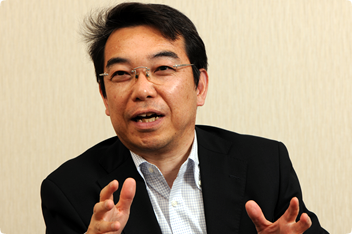How far will innovations in semiconductor manufacturing advance?
What will be the next technology after immersion lithography?
You are a researcher dealing with the most advanced technologies. You successfully created an innovative new product utilizing the findings of your research. What is it like and how do you feel, being the world leader of a technology?

Well... Developers of IC steppers and scanners at Nikon are obliged to deal with the world at large. It makes me feel great being in that position. But I also sometimes feel anxiety or loneliness, wondering if a theory I’m working on might be wrong. As long as I know that a competitor is working on the same research subject as mine, I feel assured that I’m on the right track. But when I imagine I might be the only one in this category of research, I sometimes feel rather isolated. You may not perceive this from the outside, though. (Laughs)
How much do you think microfabrication will advance?
We tend to keep forgetting it, but our goal of business is not actually miniaturization. The goals are to improve the IC performance and reduce production costs. Miniaturization is merely one of the means we use, for miniaturization alone will not be the way we achieve these goals.
What are other ways besides miniaturization?
Have you ever heard of Moore’s Law? It is, so to speak, an empirical rule, in which IC integration doubles during one and a half to two years. There’s a study that traces the rule and tries to realize the integration in such ways as the Law outlines — a conventional type of study. This is called a more Moore study. There’s also a more than Moore study, for when there’s the intention to create a completely new device, integrating the current technologies of semiconductors of various materials and functions.
The discussion seems to be getting a little difficult for us to keep up with.
If we take cameras for example, the camera market has expanded very rapidly as film is replaced by digital. The same change may be happening here. The digital cameras we are discussing still take pictures, but the media that transfer the pictures have completely changed. In the world of IC steppers and scanners, the brightness of a lens and the technology that determined laser light wavelengths had been the two major factors that commanded the quality of a device. When the study of the more than Moore theory further advances, it may bring a drastic change in the development of IC steppers and scanners.
Is that the subject of your study now?
The task for now is to look for a possibility in every perspective. Immersion lithography technology was once a vanguard in the industry, but has now become common knowledge. The researchers of the world are looking for the next breakthrough. I am one of them.
